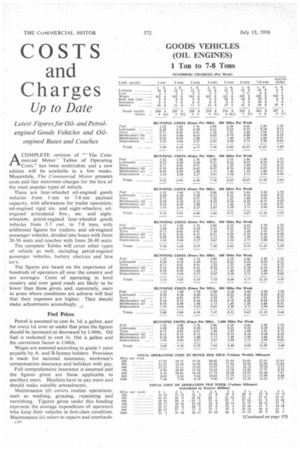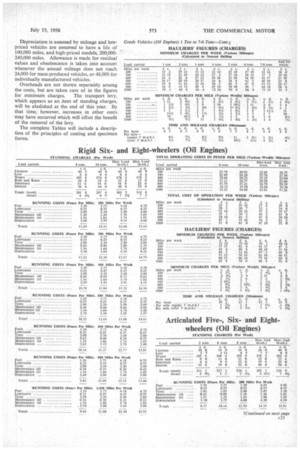COSTS and Charges
Page 58

Page 61

If you've noticed an error in this article please click here to report it so we can fix it.
Up to Date
Latest Figures for Oiland Petrolengined Goods Vehicles and Oilengined Buses and Coaches ACOMPLETE revision of " ' The Commercial Motor ' Tables of Operating Costs" has been undertaken and a new edition will be available in a few weeks. Meanwhile, The Commercial Motor presents costs and fair minimum charges for the hire of the most popular types of vehicle.
These are four-wheeled oil-engined goods vehicles from 1-ton to 7-8-ton payload capacity, with allowances for trailer operation; oil-engined rigid sixand eight-wheelers; oilengined articulated five-, sixand eightwheelers; petrol-engined four-wheeled goods vehicles from 5-7 cwt. to 7-8 tons, with additional figures for trailers; and oil-engined passenger vehicles, divided into buses with from 26-56 seats and coaches with from 26-40 scats.
The complete Tables will cover other types of vehicle as well, including petrol-engined passenger vehicles, battery electrics and hire cars.
The figures are based on the experience of hundreds of operators all over the country and are averages. Costs of operating in level country and over good roads are likely to be lower than those given, and, conversely, users in areas where conditions are adverse will find that their expenses are higher. They should make adjustments accordingly. .
Fuel Prices Petrol is assumed to cost 4s. id. a gallon, and for every id. over or under that price the figures should be increased or decreased by 1/49th. Oil fuel is reckoned to cost 3s. 10d. a gallon and the correction factor is 1/46th.
Wages are assessed according to grade 1 rates payable by Aand B-licence holders. Provision is made for national insurance, workmen's compensation insurance and holidays with pay.
Full comprehensive insurance is assumed and the figures given are those applicable, to ancillary users. Hauliers have to pay more and should make suitable amendments.
Maintenance (d) covers routine operations, such as washing, greasing, repainting and varnishing. Figures given under this heading represent the average expenditure of operators who keep their vehicles in first-class condition. Maintenance (e) refers to repairs and overhauls.
c20 Depreciation is assessed by mileage and lowpriced vehicles are assumed to have a life of 100,000 miles, and high-priced models, 200,000240,000 miles. Allowance is made for residual values and obsolescence is taken into account whenever the annual mileage does not reach 24,000 for mass-produced vehicles, or 48,000 for individually manufactured vehicles.
Overheads are not shown separately among the costs, but are taken care of in the figures for minimum charges. The transport levy, which appears as an item of standing charges, will be abolished at the end of this year. By that time, however, increases in other costs may have occurred which will offset the benefit of the removal of the levy.
The complete Tables will include a description of the principles of costing and specimen forms.












































































































